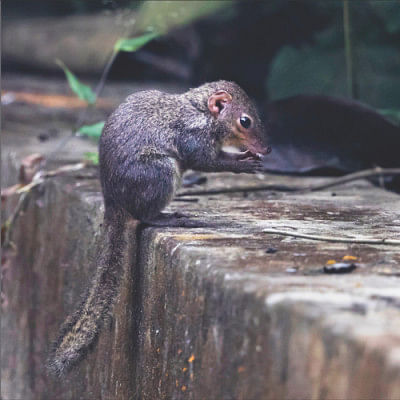Tree Shrew

It was a bright, sunny morning in early March. Reaching Satchori National Park, I discovered my guide Rahim had not arrived. So I decided to wander along the road outside the park. With dense foliage on both sides, this stretch often yielded good birds. Today, however, the pickings were slim. Even my old standby – a Plum-headed Parrot couple nesting in a roadside tree's cavity – was empty. It would be another month before their eggs hatched and mom became busy feeding her chick.
Returning to my rendezvous spot I found Rahim waiting for me. I threw a water bottle into my backpack and, lugging my camera gear, we walked to the park entrance. Our destination was the watchtower, about half a kilometer down a concrete path through the forest. As we crossed a culvert running over a stream (the name Satchori means Seven Streams) I kept searching the trees for birds, but spotted nothing.
As we continued our trek, we both saw a small creature sitting on the raised guard-wall on the right of the path. Sitting up on its hind legs, it was eating something off its fore legs. I thought it was a squirrel and not even try to photograph it. But Rahim stopped dead on his tracks. "It's just a squirrel," I told him. "No, sir, it looks different. The head is long and pointed. Perhaps it is a Tree Shrew," he said. That's when I raised my camera. It was remarkably free of fear at our approach as I took some photographs. After a few seconds it jumped from the wall and disappeared into the forest floor. We went off to the tower to look for birds. The little animal was forgotten.
A few days later, I was looking at Dr. Monirul Khan's Photographic Guide to the Wildlife of Bangladesh when I ran into a photograph of this animal. (By the way - this book by Dr. Khan, winner of the Bangabandhu Award for Wildlife Conservation, is a treasure trove of our wildlife and birds.)
According to the book, it was a Northern Tree Shrew, also known as Gecho Chhucho in Bangla. Its tail is bushy, but less so than the squirrel's. Its body is 20cm long; the tail is another 20cm. It is not a rodent, but looks in between a squirrel and a rat. Like a squirrel, it holds its food in its forepaws while eating. It is usually silent and spends much time on the ground. Its ears are interesting: large and with unique ear flaps. Feeding mainly on fruits and insects, it breeds year round. In Bangladesh it is found in the forests of Sylhet, Chittagong and Madhupur.
Globally, there are 19 species of Tree Shrews that comprise the order Scandentia. Their family is called Tupaiadae; our Northern Tree Shrew's Latin name is Tupaia belongeri. The word Tupaia comes from the Malay word Tupai meaning squirrel or small animals resembling squirrels. The Tree Shrew was first described by Sir Stamford Raffles in 1821. The Northern Tree Shrew can be found in a handful of countries to the East and Southeast of Bangladesh.
Our time in the watchtower was amply rewarded with birds. But it is the Northern Tree Shrew that I will remember most from that day at Satchori.
facebook.com/ikabirphotographs or follow ihtishamkabir on Instagram.

 For all latest news, follow The Daily Star's Google News channel.
For all latest news, follow The Daily Star's Google News channel. 



Comments